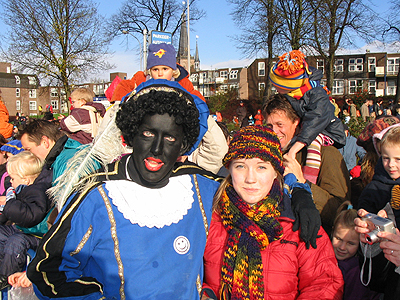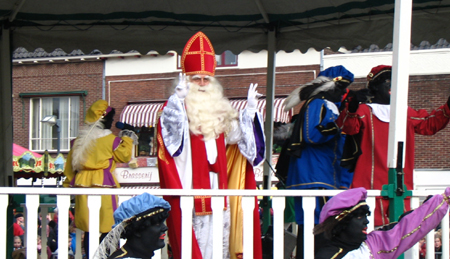
A
"Zwarte Piet" poses for a photograph with Amy Renes, whose
cheeks are bulging from the cookies and candy he insisted that she
try.
Umbrellas bounced along the side of the river, creating a colorful objection to the November rain. Though cold and rainy, weather was no reason for the faithful citizens of Doetinchem to stay home. Hidden under the umbrellas, I was part of the excited crowd, waiting for the arrival of an important figure in the Netherlands, whose name suggests joy, family, and large amounts of sugar. Sinter Klaas.

A
"Zwarte Piet" poses for a photograph with Amy Renes, whose
cheeks are bulging from the cookies and candy he insisted that she
try.
One of the preparations is the arrival of Sinter Klaas. Historically, Sinter Klaas comes from Turkey, but now spends most of his time in sunny Spain. Every year, he makes his famous journey from Spain to the sea ports and rivers of the Netherlands on his boat. This advent was the one I was to witness by our city’s river.
I was excited to see Sinter Klaas, with anticipation a little like seeing a celebrity. This was not my first glimpse of the holiday, though. Weeks earlier, stores had started filtering Sinter Klaas merchandise onto shelves, decorations onto storefronts. Also, my family and friends had fun telling me about everything done leading up to December 5.
For example, as soon as Sinter Klaas has come to the country, children can set out their shoes during the night for a special treat. The children can leave drawings for Sinter Klaas and carrots, for Sinter Klaas’s white horse Amerigo. These are traded for small toys or chocolate in the shape of the child’s first initial.
My family and friends also filled me in about all the foods I could expect to try. Some Sinter Klaas-musts are hot chocolate, marzipan, and speculaas, a spiced cookie. I was also able to try out a recipe of “pepernoten” with a friend. Very popular during all Sinter Klaas festivities, pepernoten are small round cookies brought by Sinter Klaas and his helpers.
These helpers of Sinter Klaas might be a strange, even scary sight in most countries. In the Netherlands, however, they are fully embraced. With bright outfits, tar-black skin, and lips the color of maraschino cherries, “Zwarte Pieten,” or Black Petes, make quite an appearance.
Their job, however, is far more important; help Sinter Klaas in every way possible. This includes quite a workload: making pepernoten, building toys, delivering toys, and anything else in between.
Opinions on the origin and reasoning behind the black skin vary, but everyone would agree that Sinter Klaas couldn’t carry on without Zwarte Piet by his side.
Back by the river, the first boat we saw was filled with Zwarte Pieten, dancing and carry large sacks of pepernoten. Four boats and a few mouthfuls of pepernoten later, Sinter Klaas had arrived.
 One
thing I found interesting about Sinter Klaas was his appearance,
which was much more stately and religious than Santa Claus. He had
something like a bishop’s hat, a long red robe, and a golden
staff. Still, I could see a familiar white beard and rosy cheeks.
One
thing I found interesting about Sinter Klaas was his appearance,
which was much more stately and religious than Santa Claus. He had
something like a bishop’s hat, a long red robe, and a golden
staff. Still, I could see a familiar white beard and rosy cheeks.
After dear old Sint finally passed our way, we joined the crowd to drink some hot chocolate and sing traditional songs. I tried my best to learn the lines, which were already imprinted in the memory of any Dutch child, but I mostly got as far as remembering the one line about Sinter Klaas’s horse (“Amerigo!”).
Thankfully, I had more time to practice songs. My host family celebrated Sinter Klaas a few weeks after he had come into the Netherlands. After a delicious meal of spaghetti, my family, some relatives, and I sang our way through a long list of “liedjes.”
Little did I know, the songs would be interrupted by Sinter Klaas himself, coming to drop off all the presents. I was quite startled when I we all heard a loud “boom” at the front door and then saw a shower of pepernoten coming in. Everybody screamed and played along to give the younger ones a performance. Further investigation came up with no bearded intruder, but a few sacks in the garage, filled to the top with presents.
Our family had traded names earlier so we all received presents from a secret person, along with a poem. Poems are an important part of Sinter Klaas celebrating; they should poke fun of the reader or at least get a laugh. I was able to write my poem in Dutch with the help of an online rhyming dictionary, a lot dictionary page-flipping, and my host mom.
Everyone had a good time reading their poems and being able to joke without getting in trouble. Not only did the poems tease the adults, but the younger ones got teased as well. They were told that Sinter Klaas might accidentally give the presents to the wrong child, and they should behave because Sinter Klaas might be watching. Lighthearted teasing like this is not quickly forgotten, and so gets passed from generation to generation.
Now Sinter Klaas has past, though the pepernoten are still coming out of our ears. I am thankful I was able to learn so much about this Dutch holiday. The whole month, I had a lot of fun. Some things were so enjoyable, I just might bring them back to Iowa. Now, to quote a traditional Sinter Klaas song, “Dag, Sinterklaasje!”